A Walking Safari in Southern Tanzania
On foot in the vast wilderness, exposed, all senses on high alert. The gentle breeze rustles through the dry leaves, a twig snaps underfoot. One eye on your guide watching for his reactions, whilst also trying to scan the surrounding wilderness, all while ensuring each footstep is carefully placed. There is little that compares to the excitement of a walking safari in the wild expanse of southern Tanzania in October.
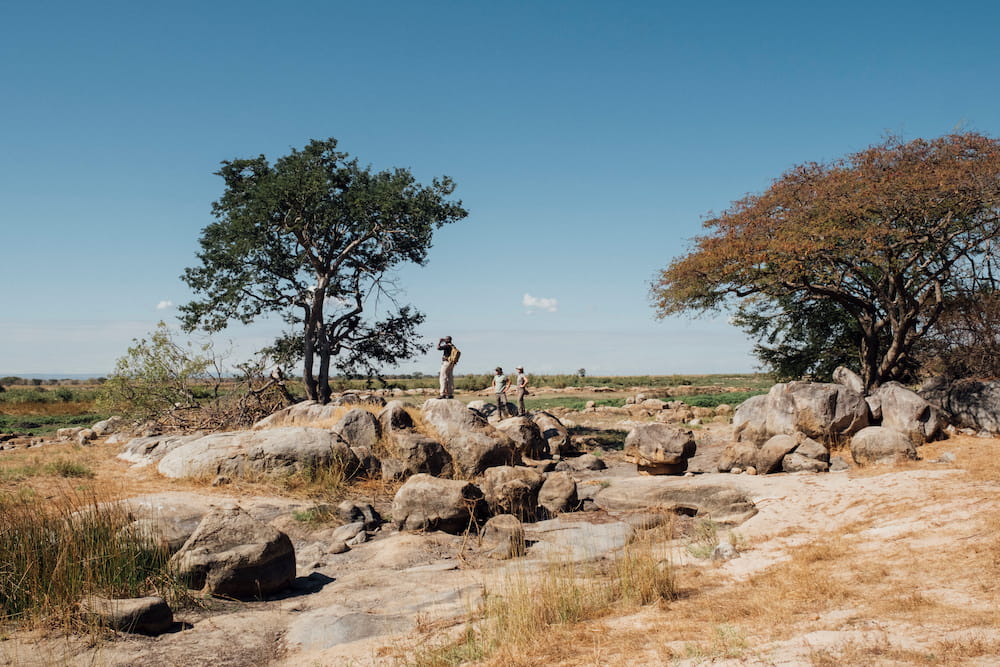
Walking conditions in southern Tanzania consistently improve throughout the dry season, peaking in October.
Choosing the right season
By early June, the season of the long rains in East Africa has usually come to an end, leaving the landscape in many of the parks green and lush with thick vegetation and tall grasses. Rivers are flowing, lakes and watering holes are full, and wildlife is typically spread out enjoying the abundance of nutritious grazing and easy access to water. However, as the dry season begins to take hold, the vegetation thins and water sources dwindle, setting the stage for perfect game viewing conditions.
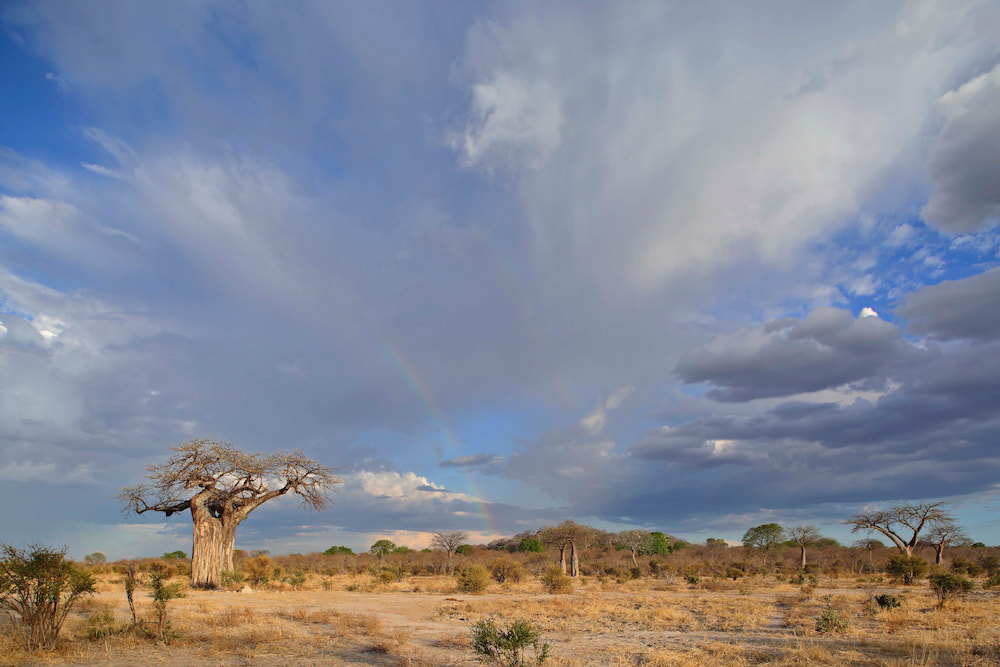
Perfect walking conditions across Ruaha National Park in October.
Across all northern and southern Tanzania, the dry months are marked as high season, and with good reason. The northern Serengeti turns into a show ground as thousands of tourists descend upon the Mara River area hoping to witness the spectacle of a river crossing by the migrating herds. Tarangire National Park, one of the most underrated and overlooked parks in northern Tanzania, offers the area’s only permanent water source throughout the dry season, attracting incredible numbers of mammals from all the surrounding areas into the park, creating phenomenal game viewing opportunities. However, on the topic of overlooked and underrated, there is little that compares to the limited attention that southern Tanzania receives. The vast landscapes of Nyerere and Ruaha national parks offer a wild and wildlife rich safari experience with a level of exclusivity unheard of in northern Tanzania. And, as per the rest of East Africa, the dry season has a profound impact on the experience offered.
“Nyerere has a very wild feel to it. Here, the wilderness factor is really incredible.” – Bruce Arnott, Asilia walking guide
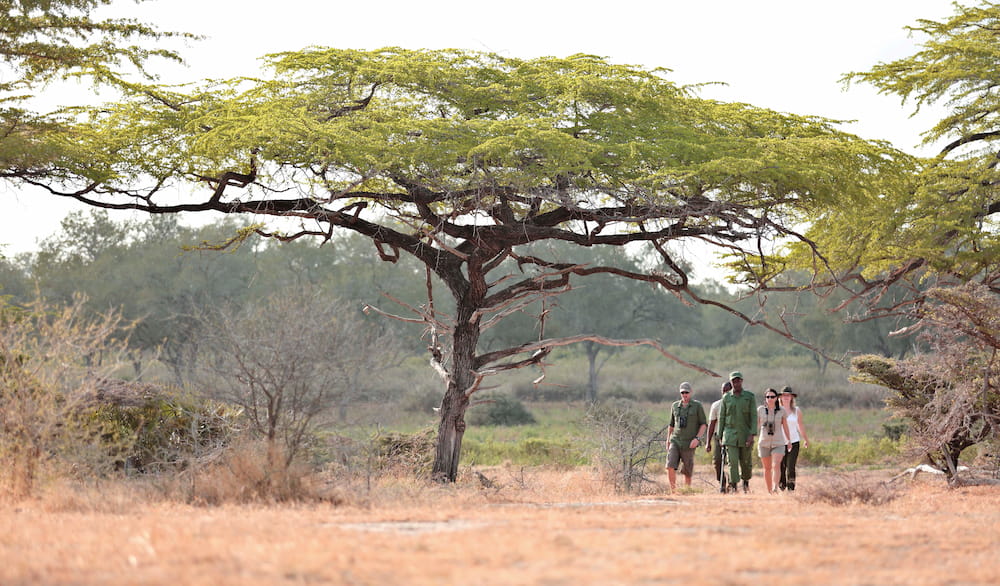
Nyerere National Park offers a diverse walking experience.
Walking in October
October is usually the last full calendar month of the dry season in Tanzania. In November, the humidity starts to build, and the afternoons increasingly see the threat of a rain shower. Eventually, the clouds burst, and the first rains fall, their moisture swallowed by the parched earth and dry vegetation within seconds. As the afternoon showers settle into a regular cadence, so the landscape once again transforms, turning green and lush as the vegetation regrows and thickens. Arriving in southern Tanzania ahead of the short rains is crucial if you are here for the incredible walking this region offers. By October, the effects of dry season are approaching their most severe, arguably creating the best walking safari conditions in Africa.
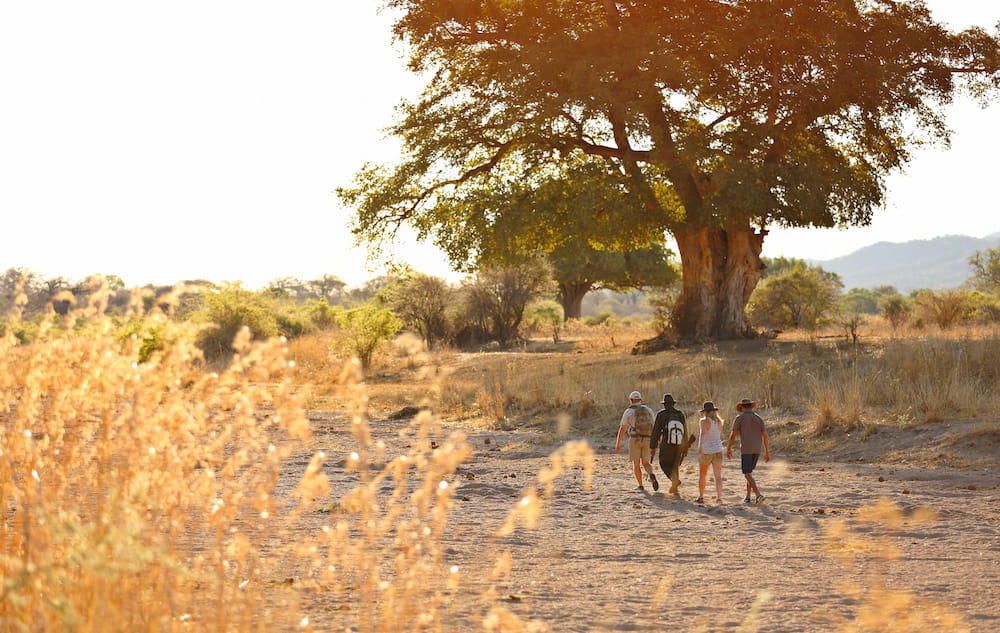
A walking safari follows the course of the dry Mwagusi River in Ruaha National Park.
Any guided walk through the bush can be called a walking safari. However, not all walking safaris are created equal, as those who have experienced more than one walking safari will be able to attest. The condition of the bush is a crucial factor that needs to be carefully considered. During, or shortly after the rainy seasons, the bush is thick and lush resulting in poor visibility and a potentially dangerous situation as predators cannot be seen from a distance. Apart from the safety element, the vegetation also limits what you can see from an interest perspective, limiting your experience to the immediate path ahead. Grasses are often high and carry ticks or a variety of other insects after the rains, again creating an uncomfortable walking environment. After three months of a progressively developing dry season, October brings about the ultimate playground for the walking safari enthusiast. The grass is dry and very low – tick and insect free. Trees and bushes have generally lost most of their leaves and all surrounding vegetation is considerably less dense. The improved visibility allows for a wider field of vision, a safer walking experience, and the ability to actively track big game from a safe distance.
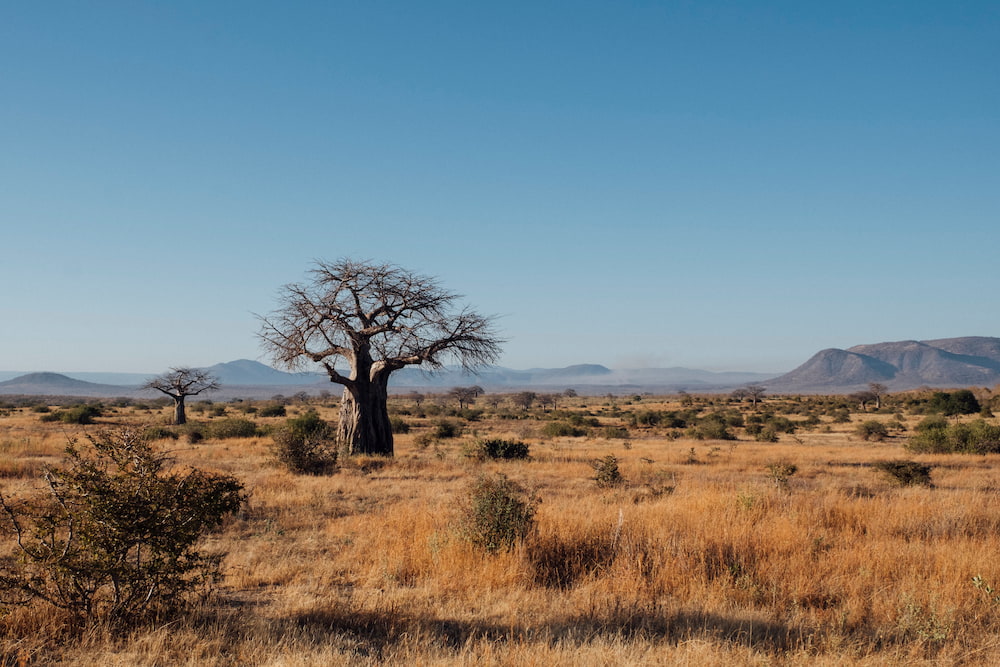
Short grass and thin vegetation across the Ruaha landscape in October.
Most importantly, an experienced and knowledgeable guide is an absolute prerequisite. If you’re walking with an Asilia guide, you’re in good hands. All our walking guides have at least 100 hours of field-based guided walking safari experience, a certificate in advanced rifle handling, and a certificate of competency in the handling of dangerous game. These are our most experienced guides, and their passion for a walking safari is what makes them great. Their love of the wilderness is what drives them, and they are excited to share it with you.
The experience
After a light breakfast in camp and a pre-walk safety briefing, strike out on foot into the surrounding wilderness. Following behind your Asilia walking guide in single file, the sanctuary of camp quickly disappears from view and the enormity of your surroundings comes into focus. The brain seems to recognise this shift away from the ordinary, as senses are suddenly primed and dialled up to “sensitive”. Without the din of a heavy diesel engine running in the background, almost every sound is now audible, from Fish Eagles overhead to the grasshoppers hiding in the short grass. The warm breeze carries the constantly changing notes of the surrounding vegetation, and sometimes the decay of a kill before it even comes into sight. Occasionally, the opportunity arises to track large mammals as they meander towards watering holes or devour the remnants of last night’s kill, but much of the walking safari experience is in the observation of the smaller ecosystems that all play a crucial role in the health of the environment. There are animal tracks to examine and identify, scent markings, termite mounds, insects, burrows and nests – all of which is frequently unseen or ignored from the height of a vehicle.
“Early mornings at the end of the dry season are the very best time for a rewarding walking safari.” – Bruce Arnott, Asilia walking guide
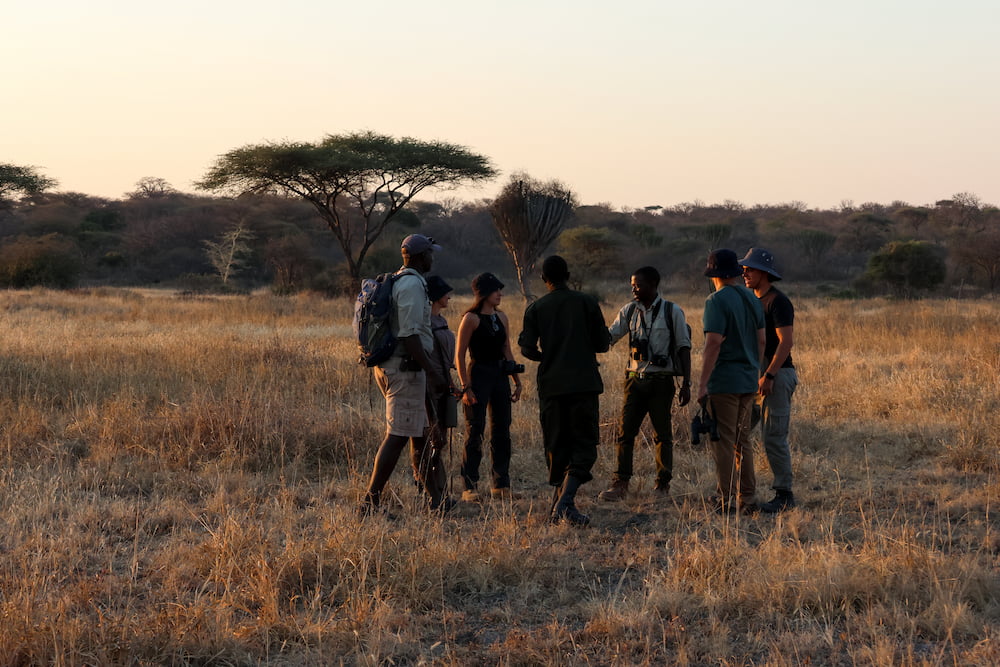
A walking safari stops to discuss a point of interest in the morning light.
Ruaha and Nyerere national parks offer a diverse and varied safari experience between not only each other, but also when compared to the parks of northern Tanzania. At the height of dry season in southern Tanzania, the landscape, wildlife, and access to water align to create perfect walking safari conditions. Nyerere National Park offers a superb diversity of habitat across river systems and forested areas thick with riverine trees. The landscape feels genuinely wild and unexplored, creating an incredible wilderness experience. Walking along the banks of the waterways and lake systems in the vicinity of Roho ya Selous make for exciting opportunities to view hippo arguing over territory in the dwindling waters, and the interactions between crocodile as they bask in the sun. In Ruaha National Park, the sandy bed of the dry Mwagusi River is patterned with animal prints. Elephant use their tusks and trunks to dig beneath the sandy surface to the cool water below, opening a temporary well point which other wildlife look to utilise after the elephant have moved on. Prides of lion lazily lounge under the trees on the banks, half an eye open in case an easy meal appears within range. To simply sit in the cool of the shade, absorbing the sounds and smells of the bush, whilst overlooking the sights of a watering hole below you. These are the memories that last a lifetime.
“Southern Tanzania is incredible for walking. Really, really something special in the world of walking in Africa. Very wild, very diverse, just epic.” – Bruce Arnott, Asilia walking guide
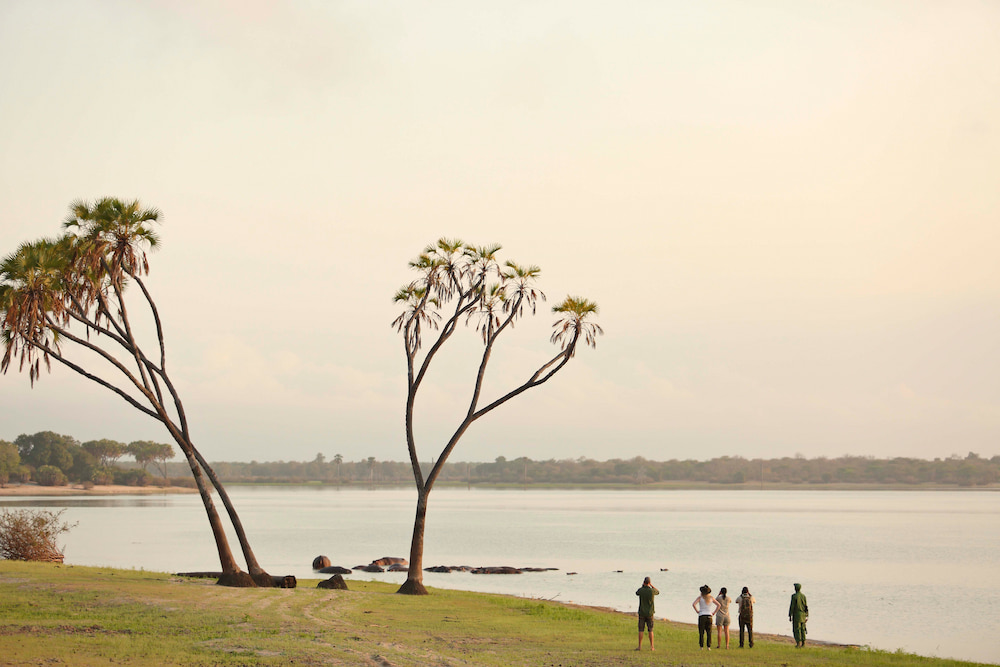
The lakes and waterways of Nyerere National Park offer a unique walking experience.
A walking safari offers a unique departure from the comfort and elevation of a vehicle, allowing for a closer connection to the environment and a heightened awareness of your place within it. Exploring on foot in southern Tanzania is arguably one of the very best safari experiences attainable in East Africa. Whether you are a seasoned walking safari enthusiast, or eager to experience this thrill for the first time, southern Tanzania in October should rank high on your bucket list.
More Destinations Articles

What’s the difference? National Parks, Game Reserves, and Conservancies in East Africa
02 February 2020To most of us, a national park, game reserve, or conservancy are all the same...

7 Of Our Favourite Things About Lake Manyara National Park
04 December 2019Lake Manyara National Park is located in Tanzania's Arusha and Manyara region...

Naboisho: Home To The Mara’s Newest Pool
28 November 2019Naboisho is now home to the Mara Naboisho Conservancy’s newest pool. During t...

Guest Gallery: The Serengeti At Its Best
27 November 2019We recently had the pleasure of welcoming guests, Chris and Monique Fallows t...





